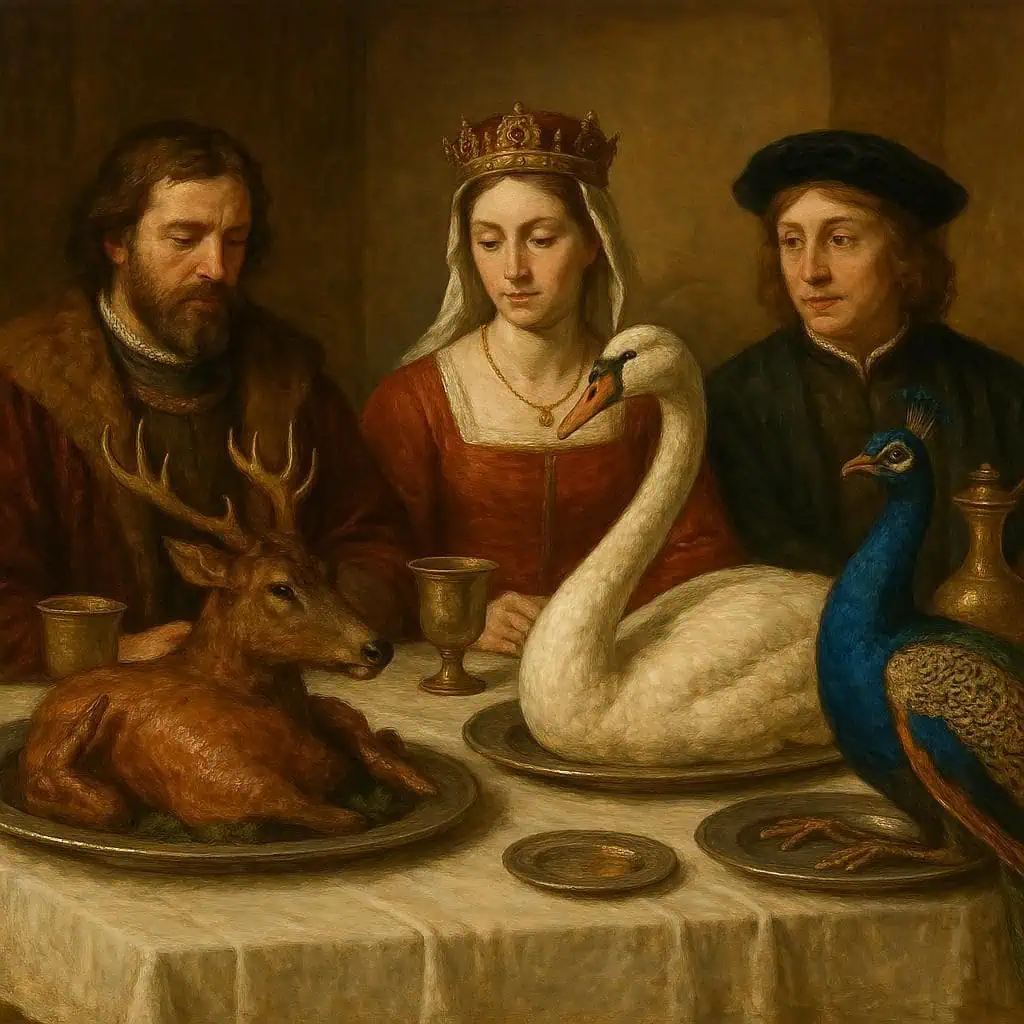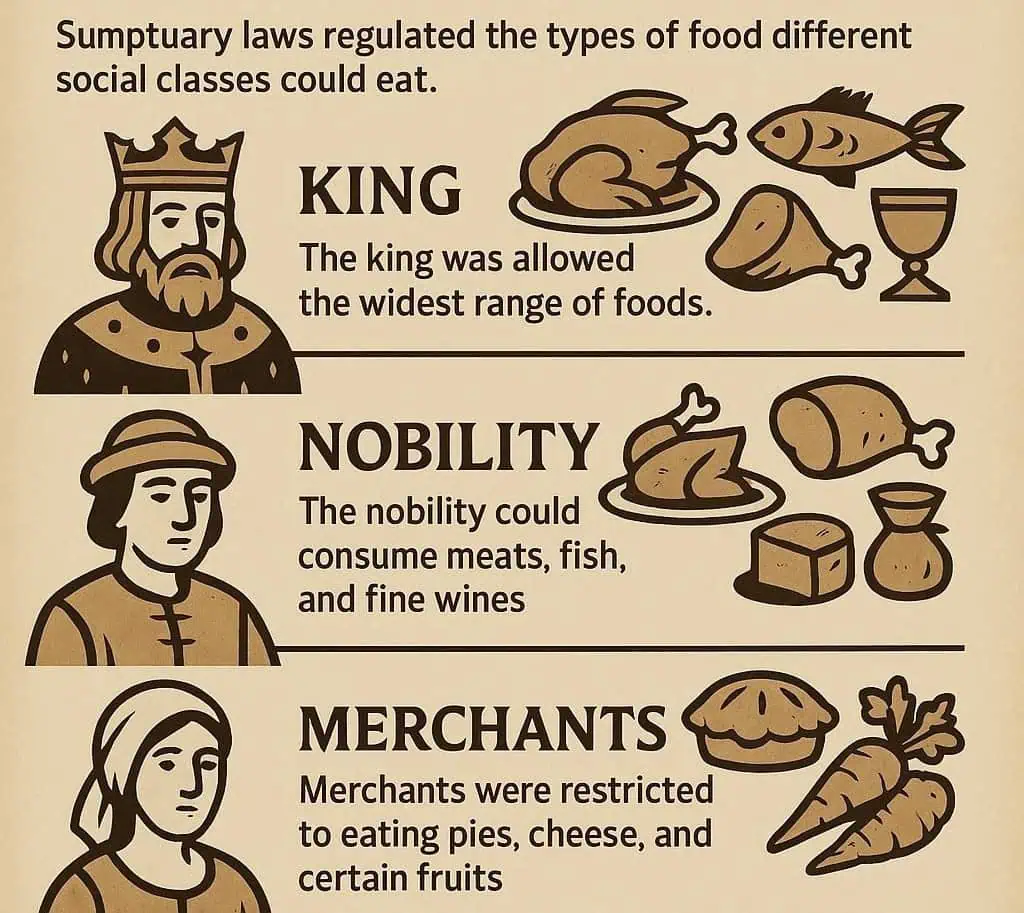When you imagine a medieval feast, you probably picture roaring fires, knights tearing into roast boar, and goblets overflowing with wine. But what most people don’t realize is that strict laws governed who could eat what. These were called sumptuary laws — rules designed to reinforce the medieval class system by controlling luxury and consumption.

They didn’t just apply to clothing or jewelry. Food — the very thing that sustained life — was also carefully regulated to remind everyone of their place in society. And some of these rules were downright strange.

🏰 What Were Sumptuary Laws?
Purpose: These laws were created to protect the social hierarchy, ensuring peasants couldn’t mimic the wealthy.
Scope: They covered clothing, feasts, and even funeral meals.
Impact: Food laws told you not only what you could wear, but what you could put on your plate.
⚖️ Example: A noble could dine on swan or crane, while a merchant — even if wealthy — might be legally barred from serving such dishes at a banquet.
🍖 Forbidden Foods for Commoners
- Exotic meats like venison, swan, and peacock were often reserved for nobles.
- Ordinary folk were restricted to chicken, pork, beef, and bread — though even the quality of bread could mark your status.
- Certain spices such as saffron and ginger were considered too luxurious for common tables.
🔥 Did you know? In 1363, England’s Edward III issued laws that specifically stated what each social rank could eat. The wealthy merchant class, despite having money, was reminded they weren’t nobility by being barred from extravagant game meats.
🎉 Feasts Under Scrutiny
Medieval feasts were central to public life. But too much extravagance from the “wrong” people” could spark resentment. Laws attempted to regulate:
- Number of courses served (so merchants couldn’t rival kings).
- Types of birds and beasts on the table.
- Bread quality, with white bread reserved for nobles and rougher loaves for peasants.
🍷 Did you know? Some towns even banned excessive drinking vessels. A giant gold goblet at a merchant’s feast might have been considered a challenge to noble authority!
🕊️ Symbolic Foods
Certain animals and foods weren’t just meals — they were symbols of status.
- Peacocks were roasted and then redressed in their feathers, dazzling the hall. Only nobles could flaunt this.
- Swan feasts became political displays of loyalty and royal authority.
- Exotic spices like cinnamon were less about taste and more about showing you could afford distant trade.
🚫 The “Food Police” Effect
While enforcement varied, some records suggest local sheriffs and officials could intervene if laws were broken. A wealthy but low-born host might risk fines or even losing favor with the crown for serving “forbidden luxuries.”
👀 Did you know? At times, these laws weren’t just about keeping peasants down but also about curbing nobles themselves. Kings worried that their barons were outshining royal feasts, so they too faced restrictions.
🍞 Food, Morality, and Control
Sumptuary laws weren’t only about hierarchy — they were also linked to morality and religion.
- Too much indulgence was seen as gluttony, a sin.
- The Church often backed food laws to encourage piety and moderation.
- Simple meals reflected virtue; lavish banquets risked corruption.
🌍 Across Europe
England wasn’t alone.
- In France, strict rules controlled meat and wine consumption.
- In Italy, city-states issued detailed bans on excessive feasting by wealthy merchants.
- In Scandinavia, similar restrictions ensured nobles remained distinct from farmers and traders.
🍽️ Final Thoughts: A Taste of Power
The sumptuary laws of the medieval world reveal how food wasn’t just nourishment — it was politics, power, and propaganda. What you ate could announce your place in society louder than words.
So, next time you sit down to a fancy meal, imagine living in an age where a bite of swan, a sprinkle of saffron, or even a goblet of wine could get you fined, shamed, or worse. The medieval table was not just about food — it was a battleground of class, privilege, and control.

What were sumptuary laws in the medieval period?
Sumptuary laws were regulations designed to control consumption and reinforce social hierarchies. While often associated with clothing, they also affected food, dictating what different classes could eat, how many courses could be served at feasts, and who could access luxury ingredients.
How did sumptuary laws affect medieval food?
These laws restricted access to expensive or symbolic foods. Nobles could serve exotic game, fine white bread, sugar, and spices, while commoners were limited to simpler dishes like pottage, coarse bread, and ale. Even the number of courses at a banquet could be legally capped depending on social rank.
What types of foods were restricted to the elite?
Luxury foods such as swan, peacock, venison, fine manchet bread, imported wines, and costly spices like saffron and cinnamon were reserved for the wealthy. Hunting rights also reinforced these restrictions, as peasants could be punished for eating game like deer or boar.
Did sumptuary laws limit feasts and celebrations?
Yes. In places like England and Italy, laws controlled the scale of wedding feasts and banquets. Nobles could host elaborate meals, but merchants or townsfolk were legally restricted in how many courses or dishes they could serve, preventing them from “outshining” the aristocracy.
How did bread reflect social status under these laws?
Bread was class-divided. The wealthy ate fine white bread (manchet), while the lower classes ate darker rye or barley bread. Laws and pricing sometimes discouraged peasants from buying refined bread, preserving it as a visible marker of wealth and privilege.
Why did medieval rulers enforce sumptuary laws on food?
Rulers wanted to maintain clear social divisions and prevent wealthy merchants or townsfolk from imitating nobles. Controlling food and feasting ensured that status was visibly reinforced at the table, not just in clothing or possessions.






